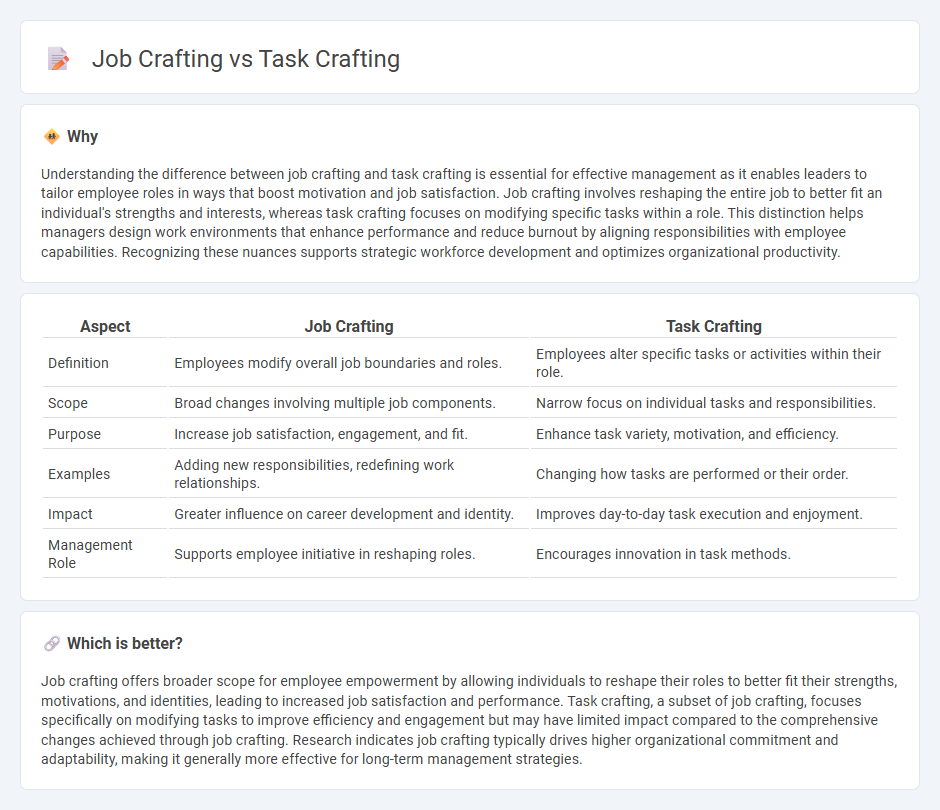
Job crafting involves employees proactively redefining their roles by altering the boundaries of their job tasks, relationships, and perceptions to better align with their strengths and interests. Task crafting specifically focuses on modifying the type, scope, or number of job tasks to enhance engagement and performance. Explore how job and task crafting strategies can improve workplace motivation and effectiveness.
Why it is important
Understanding the difference between job crafting and task crafting is essential for effective management as it enables leaders to tailor employee roles in ways that boost motivation and job satisfaction. Job crafting involves reshaping the entire job to better fit an individual's strengths and interests, whereas task crafting focuses on modifying specific tasks within a role. This distinction helps managers design work environments that enhance performance and reduce burnout by aligning responsibilities with employee capabilities. Recognizing these nuances supports strategic workforce development and optimizes organizational productivity.
Comparison Table
| Aspect | Job Crafting | Task Crafting |
|---|---|---|
| Definition | Employees modify overall job boundaries and roles. | Employees alter specific tasks or activities within their role. |
| Scope | Broad changes involving multiple job components. | Narrow focus on individual tasks and responsibilities. |
| Purpose | Increase job satisfaction, engagement, and fit. | Enhance task variety, motivation, and efficiency. |
| Examples | Adding new responsibilities, redefining work relationships. | Changing how tasks are performed or their order. |
| Impact | Greater influence on career development and identity. | Improves day-to-day task execution and enjoyment. |
| Management Role | Supports employee initiative in reshaping roles. | Encourages innovation in task methods. |
Which is better?
Job crafting offers broader scope for employee empowerment by allowing individuals to reshape their roles to better fit their strengths, motivations, and identities, leading to increased job satisfaction and performance. Task crafting, a subset of job crafting, focuses specifically on modifying tasks to improve efficiency and engagement but may have limited impact compared to the comprehensive changes achieved through job crafting. Research indicates job crafting typically drives higher organizational commitment and adaptability, making it generally more effective for long-term management strategies.
Connection
Job crafting and task crafting are connected through their focus on employees actively reshaping their work roles to improve engagement and performance. Job crafting involves modifying tasks, relationships, and perceptions about work, while task crafting specifically targets altering the scope, sequence, or type of tasks performed. Both strategies empower workers to align job demands with personal strengths and interests, enhancing job satisfaction and productivity.
Key Terms
Autonomy
Task crafting involves employees altering the number, scope, or type of tasks they perform to enhance their work experience, whereas job crafting encompasses broader changes including cognitive and relational adjustments. Autonomy plays a crucial role as it empowers employees to modify their tasks or job roles independently, fostering increased motivation and job satisfaction. Discover how leveraging autonomy in task and job crafting can transform employee engagement and productivity.
Role Redesign
Task crafting involves employees altering the number, scope, or type of tasks in their job to improve engagement and performance, while job crafting encompasses broader changes including relationships and cognitive perceptions of work. Role redesign focuses on systematically modifying job roles to better align employee strengths with organizational goals, often integrating both task and job crafting elements for optimal results. Explore effective strategies for role redesign to enhance productivity and job satisfaction.
Personalization
Task crafting emphasizes modifying specific job tasks to better align with an individual's strengths and preferences, enhancing engagement and performance. Job crafting takes a broader approach by reshaping the overall job role, including task boundaries, relationships, and cognitive perceptions, to create a personalized and meaningful work experience. Discover more insights into how these crafting strategies boost workplace satisfaction and productivity.
Source and External Links
Job crafting - Wikipedia - Task crafting involves changing the type, scope, sequence, and number of tasks in one's job as a way for employees to exert more control over their daily responsibilities.
101 examples of job crafting - Tailored Thinking - Task crafting is the tangible adjustment of work aspects such as adding, removing, or redesigning tasks, for example by limiting non-essential meetings or focusing on hard tasks when energy is highest.
Understanding the Process of Job Crafting - Personio - Task crafting allows employees to make small, practical changes to how they perform their daily tasks, such as scheduling work differently to improve effectiveness without neglecting core duties.
 dowidth.com
dowidth.com